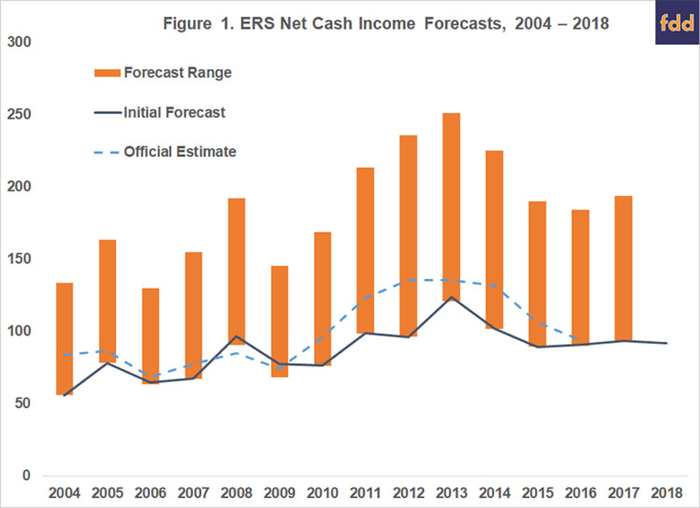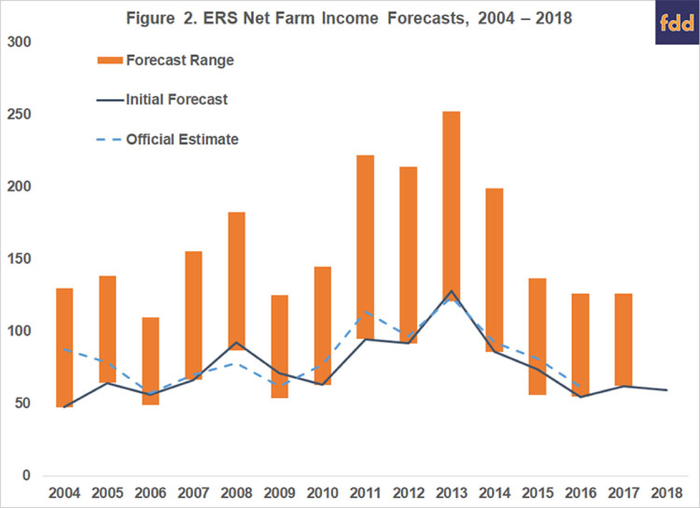February 24, 2018

By Todd Kuethe, University of Illinois
On February 7, USDA's Economic Research Service (ERS) released their initial 2018 farm income forecasts. ERS forecasts a number of farm financial measures. The two most commonly reported measures are net farm income and net cash income, and both are predicted to decline in 2018. The recent forecast history, however, suggests that the forecasts are likely to improve.
Net cash income vs. net farm income
As the name implies, net cash income is the farm sector's gross cash income less all cash expenses, such as feed, seed, fertilizer, taxes, interest payment, wages, and rent. Net farm income, on the other hand, includes additional noncash income and expenses, such as the value of inventory adjustment and capital consumption. ERS forecasts 2018 net cash income at $91.9 billion, a 5.2% reduction from their current forecast for 2017 of $96.9 billion, and ERS forecasts 2018 net farm income at $59.5 billion, a 6.7% reduction from their current forecast for 2017 of $63.8 billion.
ERS Forecast History
ERS releases four farm income forecasts a year: in February, in August, in November, and in February following the reference year (when the first forecast of the new year is released). A series of recent articles examined ERS' net farm income forecast since 1975 (August 25, 2017; August 31, 2017; November 29, 2017). The analysis shows that initial forecasts tend to under-predict realized net farm income, or in other words, the initial forecasts tend to be conservative. In addition, the analysis shows that ERS' net farm income forecasts tend to become more accurate during the forecast process, but the later forecasts often over-predict net farm income.

The dark line in Figure 1 plots ERS' initial February forecast of net cash income since 2004, and the blue dashed line represents the current official estimates of net cash income from 2004 through 2016. Over this period, ERS' initial forecast of net cash income was less than realized values for all but two years, 2008 and 2009. On average, the initial forecast was 12.6% below realized values. The vertical orange bars in Figure 1 show the range of forecasted values for each year. The ranges show that ERS' forecast of net cash income vary throughout each, with an average range of $14.3 billion. The initial forecasts tend to be among the lowest forecasted values, yet the highest forecast values typically over-predict realized net cash income. Thus, we can expect ERS to revise late net cash income forecasts up, but these revisions will likely over-shoot realized values.
Figure 2 presents the same information for ERS' net farm income measure. Between 2004 and 2016, ERS' initial net farm income forecast of was below realized values 77% of the time. The exceptions occurred in 2008, 2009, and 2013. On average, the initial forecasts were 7.8% below realized values over this period. The forecasts similarly exhibited a wide range throughout the forecast year, at an average of $19.1 billion. Again, the initial forecasts tend to be at the lower end of the forecast range, and the later forecasts tend to over-predict net farm income.

Conclusions
In sum, recent history suggests that as ERS is likely to revise their 2018 net cash and net farm income forecasts up. However, there is a tendency for these later forecasts to be a bit too optimistic. If the same pattern since 2004 holds, net cash income is likely to improve by approximately 12.6% to roughly $130.5 billion. This rough estimate is above the most recent official estimate of $94 billion in 2016 but well below the high cash incomes experienced between 2011 and 2014. Net farm income can similarly be expected to improve by approximately 7.8% to roughly $64.1 billion. This would also be an improvement relative to the most recent official estimate of $61.5 billion in 2016 but far below the record highs of 2011 to 2013.
It is also important to keep in mind that the USDA defines a farm as "any place from which $1,000 or more of agricultural products were produced and sold, or normally would have been sold, during the year." ERS' measures of farm income are, therefore, very broad, and the variation in farms around these aggregate trends is substantial.
You May Also Like




